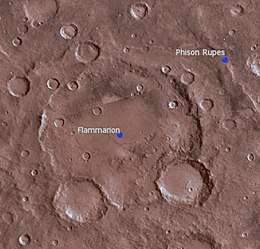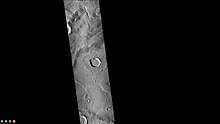Flammarion (Martian crater)
 Location of Flammarion Crater | |
| Planet | Mars |
|---|---|
| Region | Syrtis Major quadrangle |
| Coordinates | 22°24′N 173°00′W / 22.4°N 173°WCoordinates: 22°24′N 173°00′W / 22.4°N 173°W |
| Diameter | 173 km |
| Eponym | Camille Flammarion |
Flammarion is an impact crater in the Syrtis Major quadrangle on Mars at 22.4 ° N and 173.0 ° W. and is 173.0 km in diameter. Its name was approved in 1973, and it was named after Camille Flammarion.[1] There may have been a lake in the crater in the past because a channel is visible on the rim in the picture below and layers are visible in one of the pictures.
Northeast is an escarpment known as Phison Rupes a crater diameter south-southeast is Schöner.
Description
A couple of smaller unnamed craters are attached or next to the rim, four notable unnamed ones are inside the crater, in the south, two nearby unnamed craters which are less than a third of the crater's diameter are founded, the southeast one has a small central massif and a thick eastern rim.
Many places on Mars show rocks arranged in layers. Rock can form layers in a variety of ways. Volcanoes, wind, or water can produce layers.[2] Sometimes the layers are of different colors. Light-toned rocks on Mars have been associated with hydrated minerals like sulfates. The Mars Rover Opportunity examined such layers close-up with several instruments. Some layers are probably made up of fine particles because they seem to break up into find dust. Other layers break up into large boulders so they are probably much harder. Basalt, a volcanic rock, is thought to in the layers that form boulders. Basalt has been identified on Mars in many places. Instruments on orbiting spacecraft have detected clay (also called phyllosilicate) in some layers. Recent research with an orbiting near-infrared spectrometer, which reveals the types of minerals present based on the wavelengths of light they absorb, found evidence of layers of both clay and sulfates in many places, especially craters.[3] This is exactly what would appear if a large lake had slowly evaporated.[4] Moreover, since some layers contain gypsum, a sulfate which forms in relatively fresh water, life could have formed in some craters.[5]


See also
- 1021 Flammario, asteroid
- Climate of Mars
- List of craters on Mars: A-G
- List of people with craters on Mars named after them § F
- Ore resources on Mars
- Planetary nomenclature
- Water on Mars
References
- ↑ http://planetarynames.wr.usgs.gov/
- ↑ "High Resolution Imaging Science Experiment". The University of Arizona. Retrieved 2012-08-04.
- ↑ Cabrol, N. and E. Grin (eds.). 2010. Lakes on Mars. Elsevier.NY.
- ↑ Wray, J. et al. 2009. Columbus Crater and other possible plaelakes in Terra Sirenum, Mars. Lunar and Planetary Science Conference. 40: 1896.
- ↑ "Martian "Lake Michigan" Filled Crater, Minerals Hint". News.nationalgeographic.com. 2010-10-28. Retrieved 2012-08-04.